Spatiotemporal Assessment of Benzene Exposure Characteristics in a Petrochemical Industrial Area Using Mobile-Extraction Differential Optical Absorption Spectroscopy (Me-DOAS)
Abstract
1. Introduction
2. Materials and Methods
2.1. Study Area and Measurement Approach
2.2. Measurement and Analytical Methods
2.3. Data Analysis
2.4. Measurement Limitations and Data Quality Assurance for ORS Instruments
2.5. Benzene Exposure Standards
3. Results and Discussion
3.1. Monthly Variation in Benzene Concentrations
3.2. Temporal Variation of Benzene Concentrations by Measurement Session
3.3. High-Concentration Benzene “Hot Spot” Episodes
3.4. Analysis of Contributing Factors to High-Concentration Benzene Spot Occurrences
4. Conclusions
4.1. Monthly Analysis
4.2. Time-of-Day Variation
4.3. High-Concentration Hot Spots
4.4. Emission Source Characteristics
4.5. Data Quality and Limitations
Author Contributions
Funding
Institutional Review Board Statement
Informed Consent Statement
Data Availability Statement
Conflicts of Interest
References
- National Institute of Chemical Safety. Analysis of Chemical Accident Reports from the Second Half of 2015 to the First Half of 2016; National Institute of Chemical Safety: Daejeon, Republic of Korea, 2015. (In Korean) [Google Scholar]
- Ministry of Environment. Enforcement rules of the Clean Air Conservation Act; Annex 2: Designated hazardous air pollutants; Korea Legislation Research Institute: Sejong, Republic of Korea, 2023. (In Korean) [Google Scholar]
- International Agency for Research on Cancer (IARC). Chemical Agents and Related Occupations; IARC: Lyon, France, 2012; Volume 100F. [Google Scholar]
- Nordlinder, R.; Ramnäs, O. Exposure to benzene at different workplaces in Sweden. Ann. Occup. Hyg. 1987, 31, 345–355. [Google Scholar] [PubMed]
- Yin, S.N.; Hayes, R.B.; Linet, M.S.; Li, G.L.; Dosemeci, M.; Travis, L.B.; Zhang, Z.N.; Li, D.G.; Chow, W.H.; Wacholder, S.; et al. An expanded cohort study of cancer among benzene-exposed workers in China. Environ. Health Perspect. 1996, 104, 1339–1341. [Google Scholar] [CrossRef] [PubMed]
- Bloemen, L.; Youk, A.; Bradley, T.D.; Bodner, K.M.; Marsh, G. Lymphohaematopoietic cancer risk among chemical workers exposed to benzene. Occup. Environ. Med. 2004, 61, 270–274. [Google Scholar] [CrossRef]
- Gun, R.T.; Pratt, N.; Ryan, P.; Roder, D. Update of mortality and cancer incidence in the Australian petroleum industry cohort. Occup. Environ. Med. 2006, 63, 476–481. [Google Scholar] [CrossRef] [PubMed]
- Kirkeleit, J.; Riise, T.; Bråtveit, M.; Moen, B.E. Increased risk of acute myelogenous leukemia and multiple myeloma in a historical cohort of upstream petroleum workers exposed to crude oil. Cancer Causes Control 2008, 19, 13–23. [Google Scholar] [CrossRef]
- Adegoke, O.J.; Blair, A.; Shu, X.O.; Sanderson, M.; Jin, F.; Dosemeci, M.; Addy, C.L.; Zheng, W. Occupational history and exposure and the risk of adult leukemia in Shanghai. Ann. Epidemiol. 2003, 13, 485–494. [Google Scholar] [CrossRef]
- Fabbro-Peray, P.; Daures, J.P.; Rossi, J.F. Environmental risk factors for non-Hodgkin’s lymphoma: A population-based case–control study in Languedoc-Roussillon, France. Cancer Causes Control 2001, 12, 201–212. [Google Scholar] [CrossRef]
- Dryver, E.; Brandt, L.; Kauppinen, T.; Olsson, H. Occupational exposures and non-Hodgkin’s lymphoma in Southern Sweden. Int. J. Occup. Environ. Health 2004, 10, 13–21. [Google Scholar] [CrossRef]
- Houot, J.; Marquant, F.; Goujon, S.; Faure, L.; Honoré, C.; Roth, M.-H.; Hémon, D.; Clavel, J. Residential proximity to heavy-traffic roads, benzene exposure, and childhood leukemia—The GEOCAP Study, 2002–2007. Am. J. Epidemiol. 2015, 182, 685–693. [Google Scholar] [CrossRef]
- Spycher, B.D.; Lupatsch, J.E.; Huss, A.; Rischewski, J.; Schindera, C.; Spoerri, A.; Vermeulen, R.; Kuehni, C.E.; Swiss Pediatric Oncology Group and Swiss National Cohort Study Group. Parental occupational exposure to benzene and the risk of childhood cancer: A census-based cohort study. Environ. Int. 2017, 108, 84–91. [Google Scholar] [CrossRef]
- Youn, S.J.; Jo, K.H.; Kim, H.S.; Song, G.B.; Lee, S.B.; Jeong, J.Y. Measurement of hazardous air pollutants in industrial complex using mobile measurement system with SIFT-MS. J. Korean Soc. Atmos. Environ. 2020, 36, 507–521. [Google Scholar] [CrossRef]
- Mellqvist, J.; Samuelsson, J.; Andersson, P.; Brohede, S.; Isoz, O.; Ericsson, M. Using Solar Occultation Flux and Other Optical Remote Sensing Methods to Measure VOC Emissions from a Variety of Stationary Sources in the South Coast Air Basin; FluxSense AB: Västra Frölunda, Sweden, 2017. [Google Scholar]
- Statistics Korea. 2022 Social Survey Results: Environment Sector; Statistics Korea: Daejeon, Republic of Korea, 2022. (In Korean) [Google Scholar]
- National Air Emission Inventory and Research Center. 2020 National Air Pollutant Emission Inventory and Recalculated Emissions for Previous Years; Ministry of Environment: Sejong, Republic of Korea, 2020. (In Korean) [Google Scholar]
- United States Environmental Protection Agency (US EPA). Fence Line Monitoring Dashboard. Available online: https://awsedap.epa.gov/public/extensions/Fenceline_Monitoring/Fenceline_Monitoring.html (accessed on 23 June 2025).
- Johanson, J.; Mellqvist, J.; Samuelsson, J.; Offerle, B.; Rappengluck, B.; Anderson, D.; Lefer, B.; Alvarez, S.; Flynn, J. Quantification of Industrial Emissions of VOCs, NO2 and SO2 by SOF and Mobile DOAS During DISCOVER-AQ; Project No. 13-0051; Air Quality Research Program (AQRP): Tsukuba, Japan, 2013. [Google Scholar]
- National Institute of Environmental Research (NIER). Studies on the Estimation of Pollutant Emission Using Optical Techniques in the Mixed-Use Development Areas (III); NIER: Incheon, Republic of Korea, 2023. (In Korean) [Google Scholar]
- Rothman, N.; Smith, M.T.; Hayes, R.B.; Li, G.L.; Irons, R.D.; Dosemeci, M.; Haas, R.; Stillman, W.S.; Linet, M.; Xi, L.; et al. An epidemiologic study of early biologic effects of benzene in Chinese workers. Environ. Health Perspect. 1996, 104, 1365–1370. [Google Scholar]
- U.S. Environmental Protection Agency (EPA). Toxicological Review of Benzene. EPA/635/R-02/001F; U.S. EPA: Washington, DC, USA, 2002. [Google Scholar]
- Ministry of Employment and Labor (MoEL). Chemical Substances and Physical Factors Exposure Limit Notification No. 2020-48; Ministry of Employment and Labor: Sejong, Republic of Korea, 2020. (In Korean) [Google Scholar]
- Ministry of Food and Drug Safety (MFDS). Guideline for Genotoxic Impurity Assessment in Pharmaceuticals (For Civil Petitioners); Guide No. 0166-03; Ministry of Food and Drug Safety: Cheongju, Korea, 2023. (Revised 27 September 2023) (In Korean) [Google Scholar]
- Sekara, A.; Varghese, G.K.; Varma, M.K.R. Analysis of benzene air quality standards, monitoring methods and concentrations in indoor and outdoor environment. Heliyon 2019, 5, e029. [Google Scholar] [CrossRef]
- Central Pollution Control Board. National Ambient Air Quality Standards; CPCB: New Delhi, India, 2009. [Google Scholar]
- Ministry of the Environment, Japan. Environmental Quality Standards in Japan—Air Quality; Ministry of the Environment: Tokyo, Japan, 2009.
- ENVIRON. Project Environmental and Social Standards—YAMAL LNG; ENVIRON: Washington, DC, USA, 2014. [Google Scholar]
- Air Quality Observatory in the Paris Region. Air Quality in the Paris Region, Summary 2017; Airparif: Paris, France, 2018. [Google Scholar]
- Transport & Environment. European Union Air Quality Standards. Available online: https://www.transportpolicy.net/standard/eu-air-quality-standards/ (accessed on 29 July 2025).
- Woo, K.S.; Park, H.J.; Kang, T.S.; Kim, G.B.; Jeon, J.M.; Jang, B.K.; Lee, J.W.; Son, B.S. Concentration of volatile organic compounds (VOCs) in ambient air and level of residents in industrial area. J. Korean Soc. Occup. Environ. Hyg. 2015, 25, 104–114. (In Korean) [Google Scholar] [CrossRef]
- Shin, H.S.; Ahn, H.S. The study on the measurement of volatile organic compounds in the air of A and B industrial area. Anal. Sci. Technol. 2004, 17, 130–144. (In Korean) [Google Scholar]
- Bong, S.H.; Jeong, S.W.; Park, H.J.; Kim, W.S.; Kim, S.H. A study on the characteristics of ambient volatile organic compounds in Gimhae. J. Environ. Sci. 2008, 17, 871–878. (In Korean) [Google Scholar][Green Version]
- Park, J.H.; Park, H.G.; Suh, J.M. Characterization of volatile organic compounds (VOCs) concentrations in Jinju. J. Korean Environ. Sci. Soc. 2013, 22, 91–98. (In Korean) [Google Scholar][Green Version]
- Kim, M.j.; Seo, Y.K.; Cho, B.Y.; Baek, S.-O. Characteristics of Hazardous Air Pollutants in the Steel Industrial City, Pohang (II) - Volatile Organic Compounds. J. Korean Soc. Atmos. Environ. 2018, 34, 244–258. [Google Scholar] [CrossRef]
- Lee, Y.J. A Study on the Characteristics of Concentration and Source of Ambient Volatile Organic Compounds in Kwangju. Master’s Thesis, Chosun University, Gwangju, Republic of Korea, 2001. (In Korean). [Google Scholar]
- Yoon, M.R.; Jo, H.J.; Kim, G.B.; Chang, J.Y.; Lee, C.W.; Lee, B.E. Exposure to PAHs and VOCs in residents near the Shinpyeong·Jangrim industrial complex. J. Environ. Health Sci. 2021, 47, 131–143. [Google Scholar]
- Kim, D.G.; Song, I.S.; Woo, J.S.; Bae, Y.S.; Lee, Y.K.; Park, I.B.; Han, H.S.; Kim, Y.J.; Kim, J.S. Concentration distribution of toxic volatile organic hydrocarbons in Gyeonggi-do’s atmosphere. J. Korean Soc. Environ. Anal. 2018, 21, 11–23. [Google Scholar]
- Shin, S.H.; Park, J.S.; Kim, J.B.; Kim, P.; Kim, C.H.; Hwang, K.; Park, S.M.; Lee, J.; Park, J.M.; Kim, J. Characteristics of volatile organic compounds distribution in downtown Ansan near industrial complexes. J. Environ. Anal. Health Toxicol. 2024, 27, 14–28. [Google Scholar] [CrossRef]
- Choi, S.W.; Park, S.W.; Lee, C.S.; Kim, H.J.; Bae, S.; Inyang, H.I. Patterns of VOCs and BTEX concentration in the ambient air around industrial sources in Daegu, Korea. J. Environ. Sci. Health A 2009, 44, 99–107. [Google Scholar] [CrossRef] [PubMed]
- Tiwari, V.; Hanai, Y.; Masunaga, S. Ambient levels of volatile organic compounds in the vicinity of petrochemical industrial area of Yokohama, Japan. Air Qual. Atmos. Health 2010, 3, 65–75. [Google Scholar] [CrossRef] [PubMed]
- Filella, I.; Peñuelas, J. Daily, weekly and seasonal time courses of VOC concentrations in a semiurban area near Barcelona. Atmos. Environ. 2006, 40, 7752–7769. [Google Scholar] [CrossRef]
- Sarkar, C.; Chatterjee, A.; Majumdar, D.; Ghosh, S.K.; Srivastava, A.; Raha, S. Volatile organic compounds over Eastern Himalaya, India: Temporal variation and source characterization using positive matrix factorization. Atmos. Chem. Phys. Discuss. 2014, 14, 32133–32175. [Google Scholar]
- Bloemend, H.J.T.; Burn, J. Chemistry and analysis of volatile organic compounds in the environment—VOCs and the environment and public health-health effects. J. Chem. Educ. 1993, 72, 25–91. [Google Scholar]
- Chae, J.S.; Jeon, J.M.; Kang, B.W.; Kim, J.H.; Moon, K.J.; Park, G.T.; Kang, D.I. The study on emission characteristics of gas-phase hazardous air pollutants generated at the large-scale industrial complexes. J. Korean Soc. Atmos. Environ. 2024, 40, 27–47. [Google Scholar] [CrossRef]
- National Institute of Environmental Research (NIER). Monitoring of Exposure to Environmental Pollutants and Health Effects of Inhabitants in Industrial Complexes; NIER: Incheon, Republic of Korea, 2012. (In Korean) [Google Scholar]
- Jeong, G.S. The Study of Improve the Safety Management from the Disaster Accident Analysis in Yeosu Industrial Complex. Master’s Thesis, Dongshin University, Naju, Republic of Korea, 2010. (In Korean). [Google Scholar]
- Cui, H. Source profile of volatile organic compounds (VOCs) of a petrochemical industrial in the Yantze River Delta, China. Chem. Eng. Trans. 2016, 54, 121–126. [Google Scholar]
- Chen, M.H.; Yuan, C.S.; Wang, L.C. Source identification of VOCs in a petrochemical complex by applying open path Fourier transform infrared spectrometry. Aerosol Air Qual. Res. 2014, 14, 1630–1638. [Google Scholar] [CrossRef]
- Joo, K.D.; Lee, J.S.; Choi, S.B.; Shin, J.H. Study of correlation between airborne benzene and urinary trans, trans-muconic acid in petrochemical industry processes. J. Korean Soc. Occup. Environ. Hyg. 2006, 16, 356–363. [Google Scholar]
- Kim, S.H.; Park, J.U.; Moon, J.D. Change of urinary trans, trans-muconic acid before and after turnaround process in a petrochemical plant. Korean J. Occup. Environ. Med. 2008, 20, 335–342. [Google Scholar] [CrossRef]
- Chemical Safety Agency (CSA). Pollutant Release and Transfer Registers; CSA: Daejeon, Republic of Korea, 2021. (In Korean) [Google Scholar]
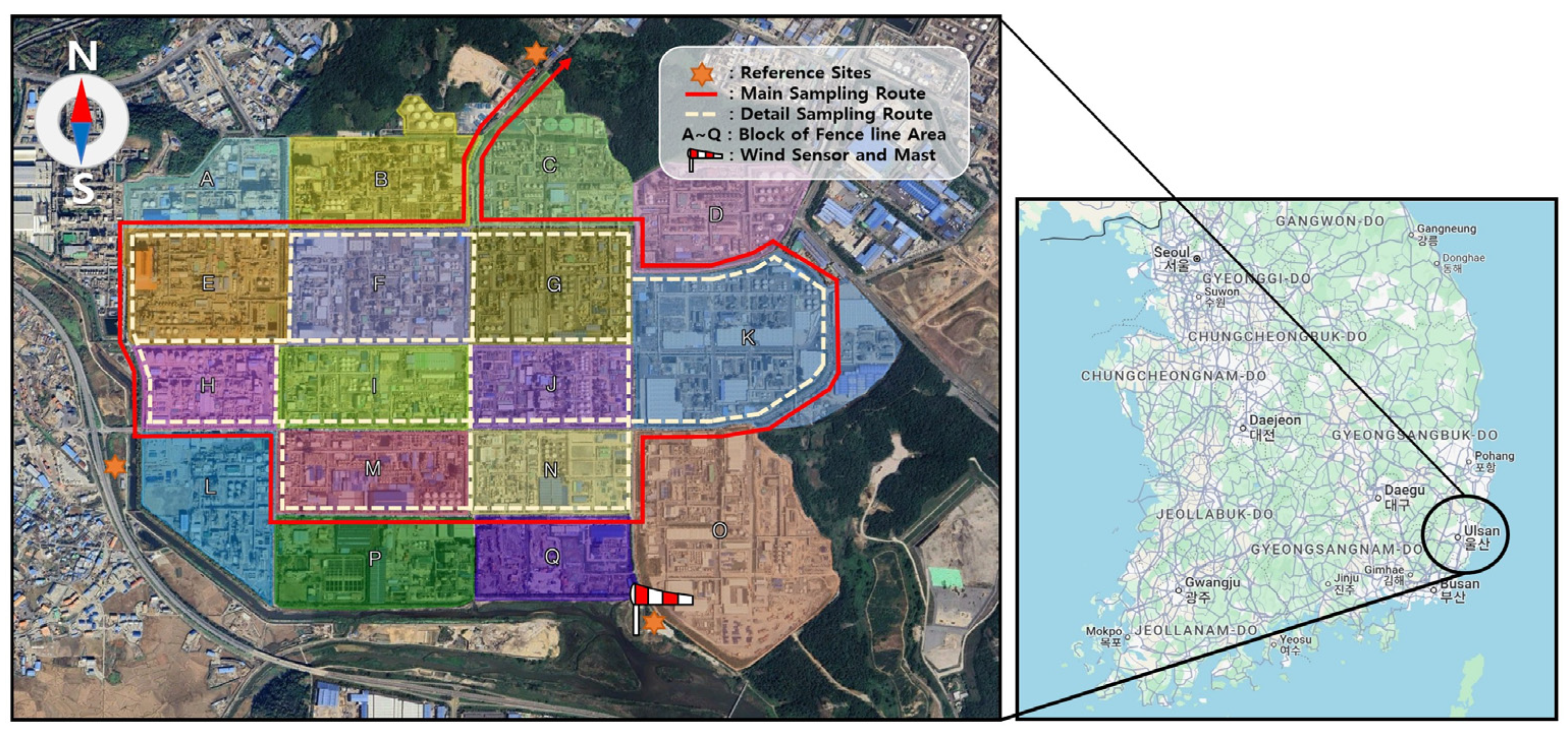
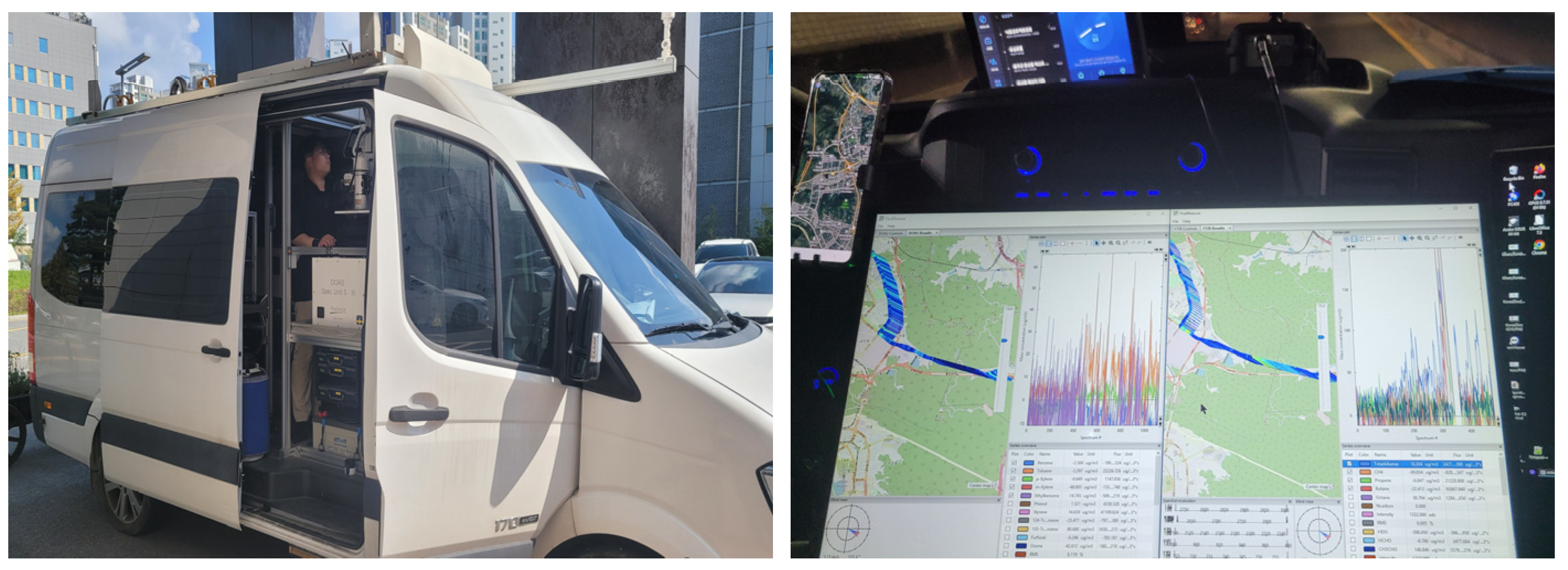

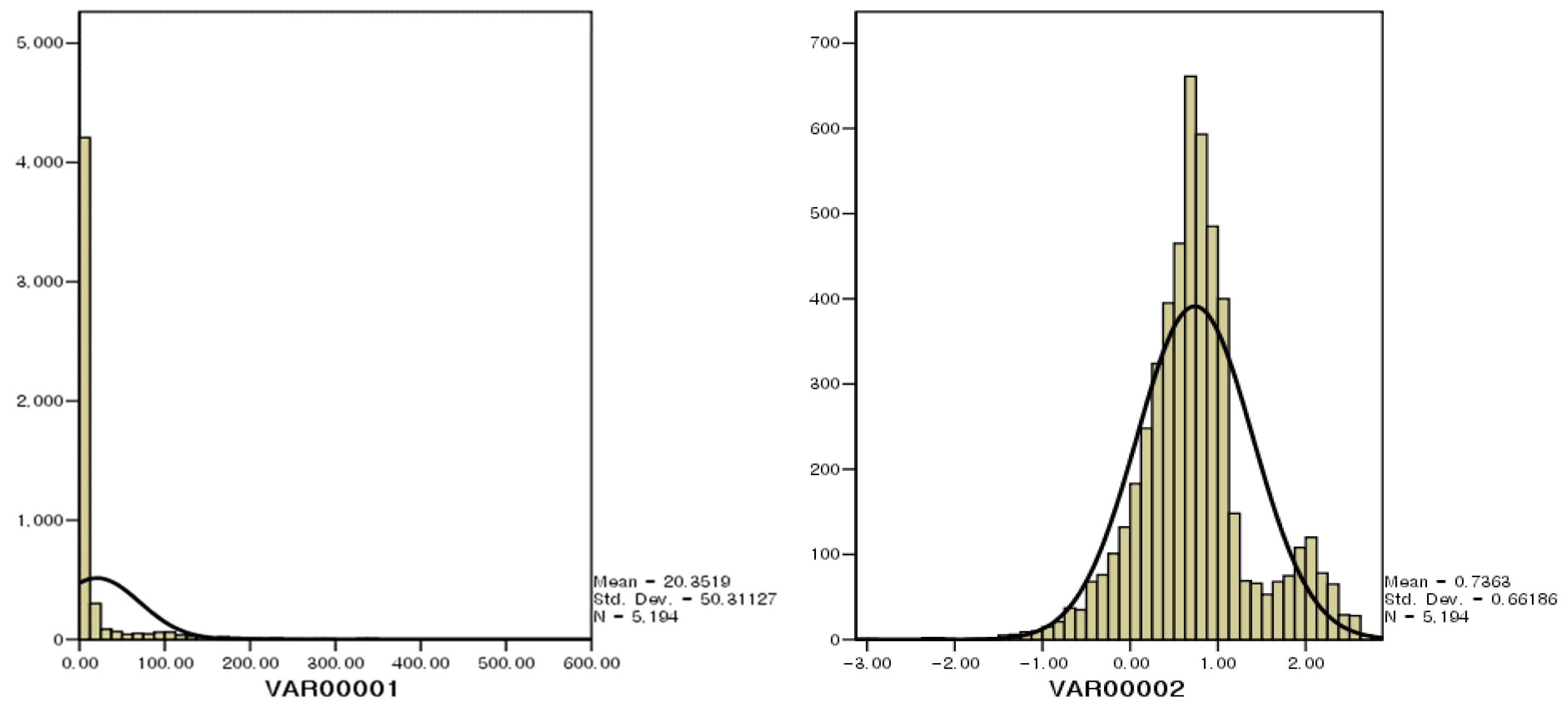
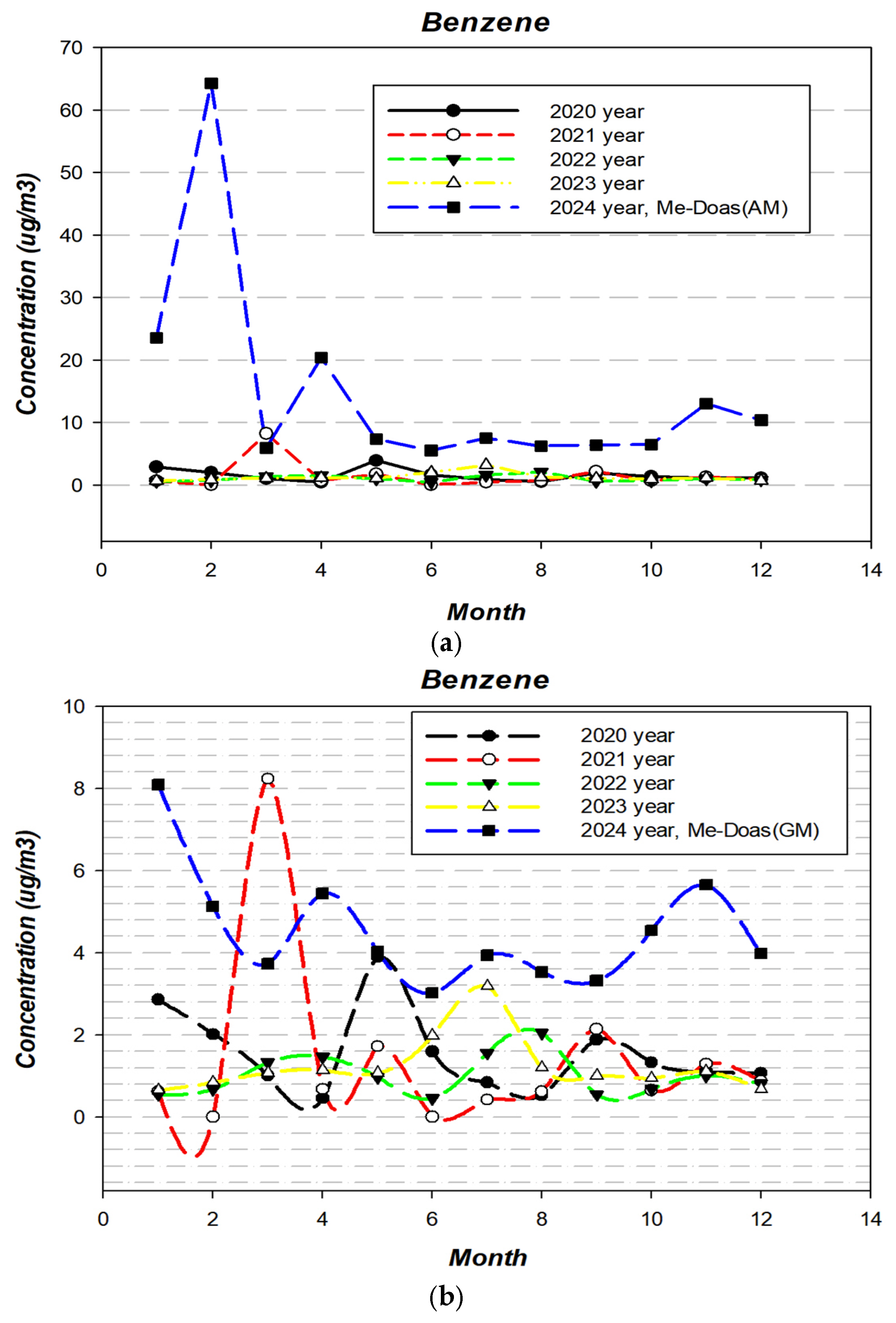
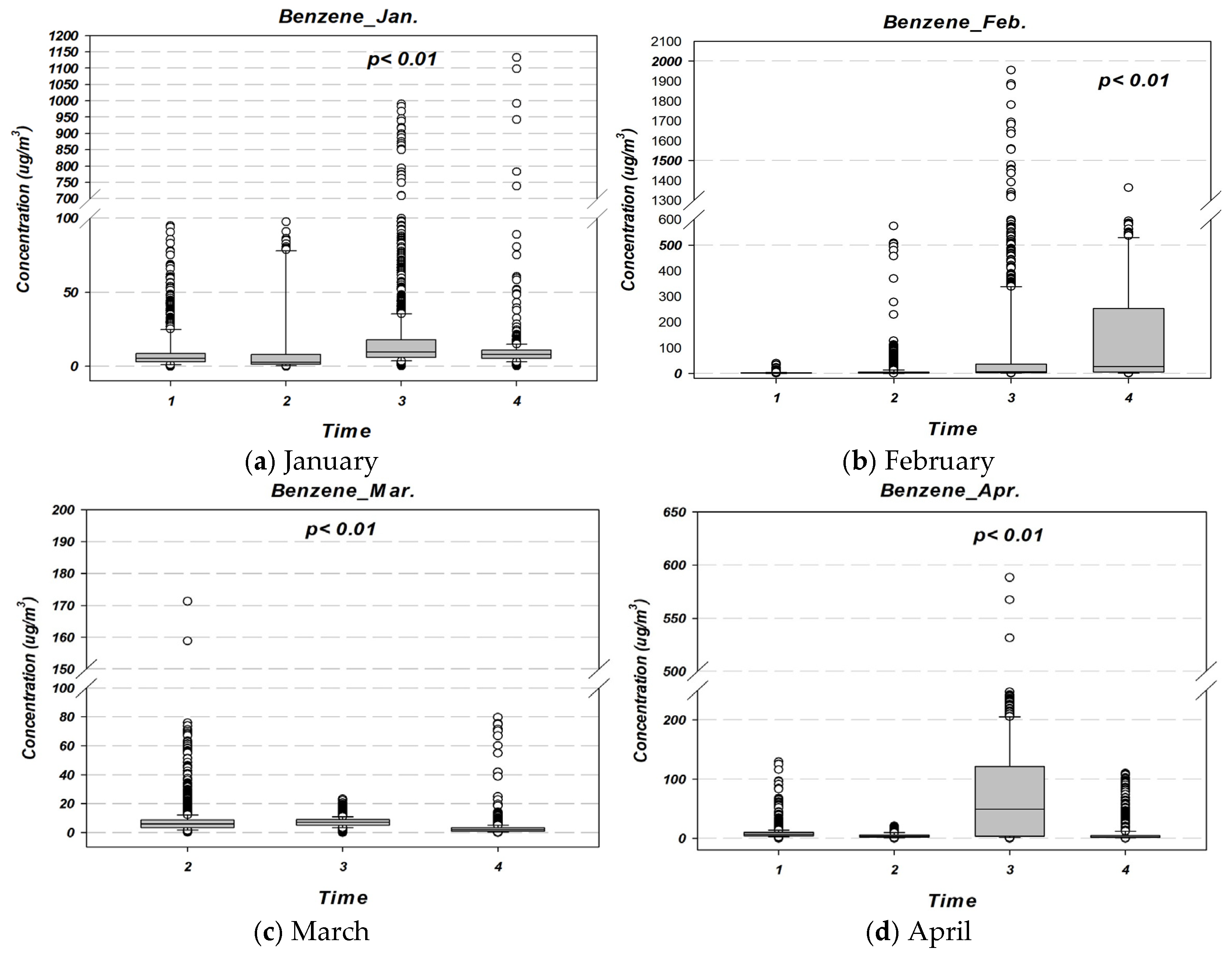
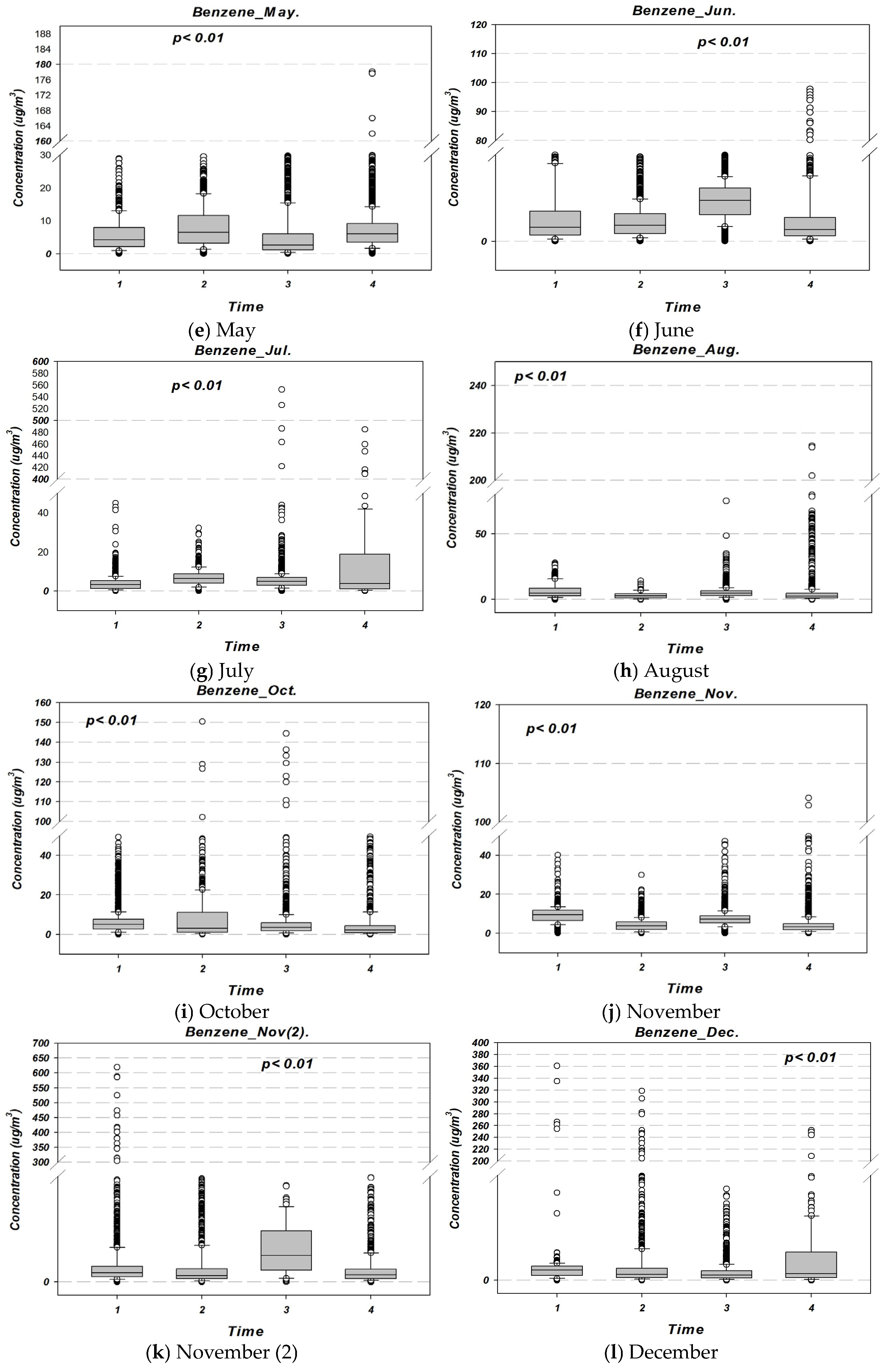

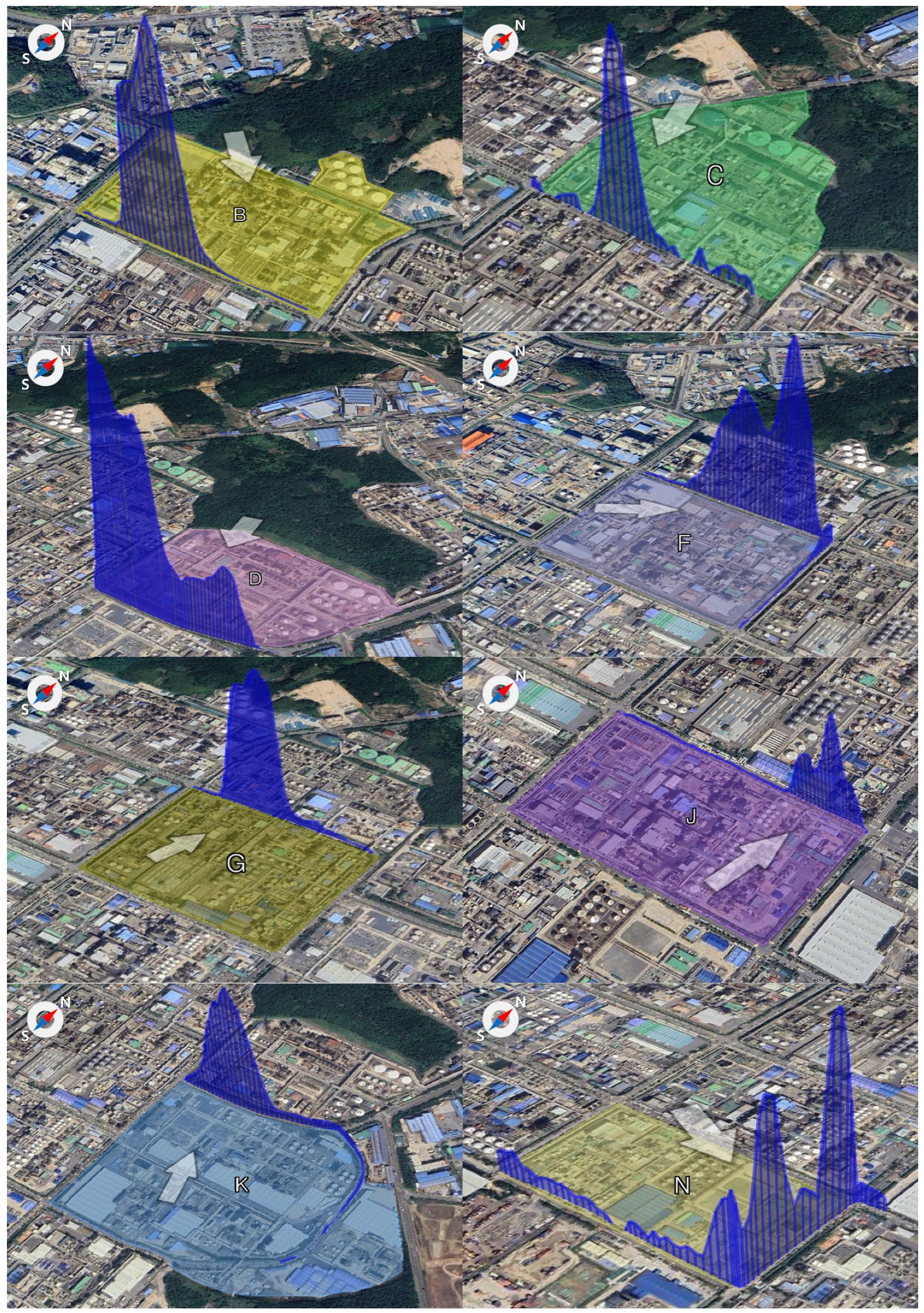
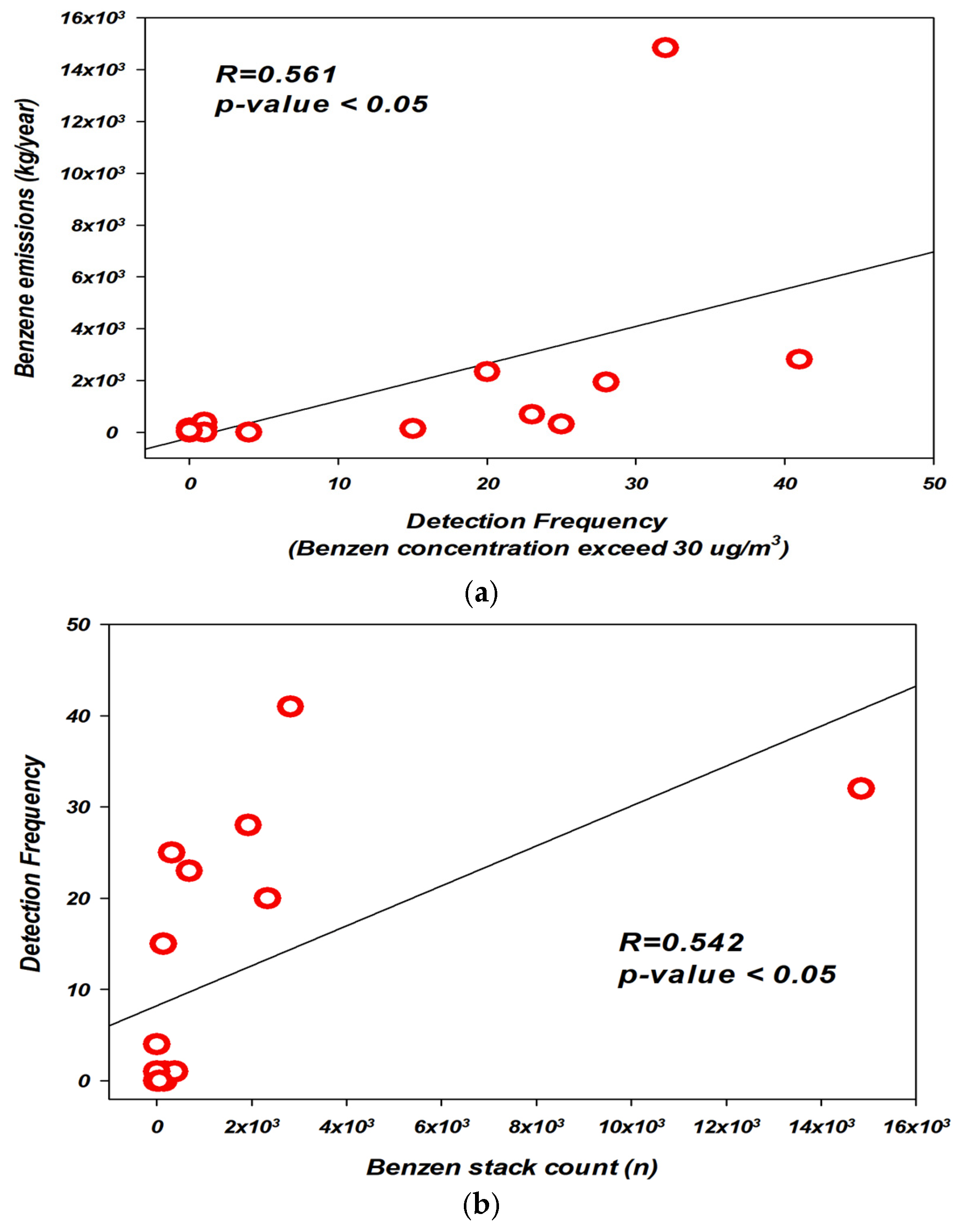
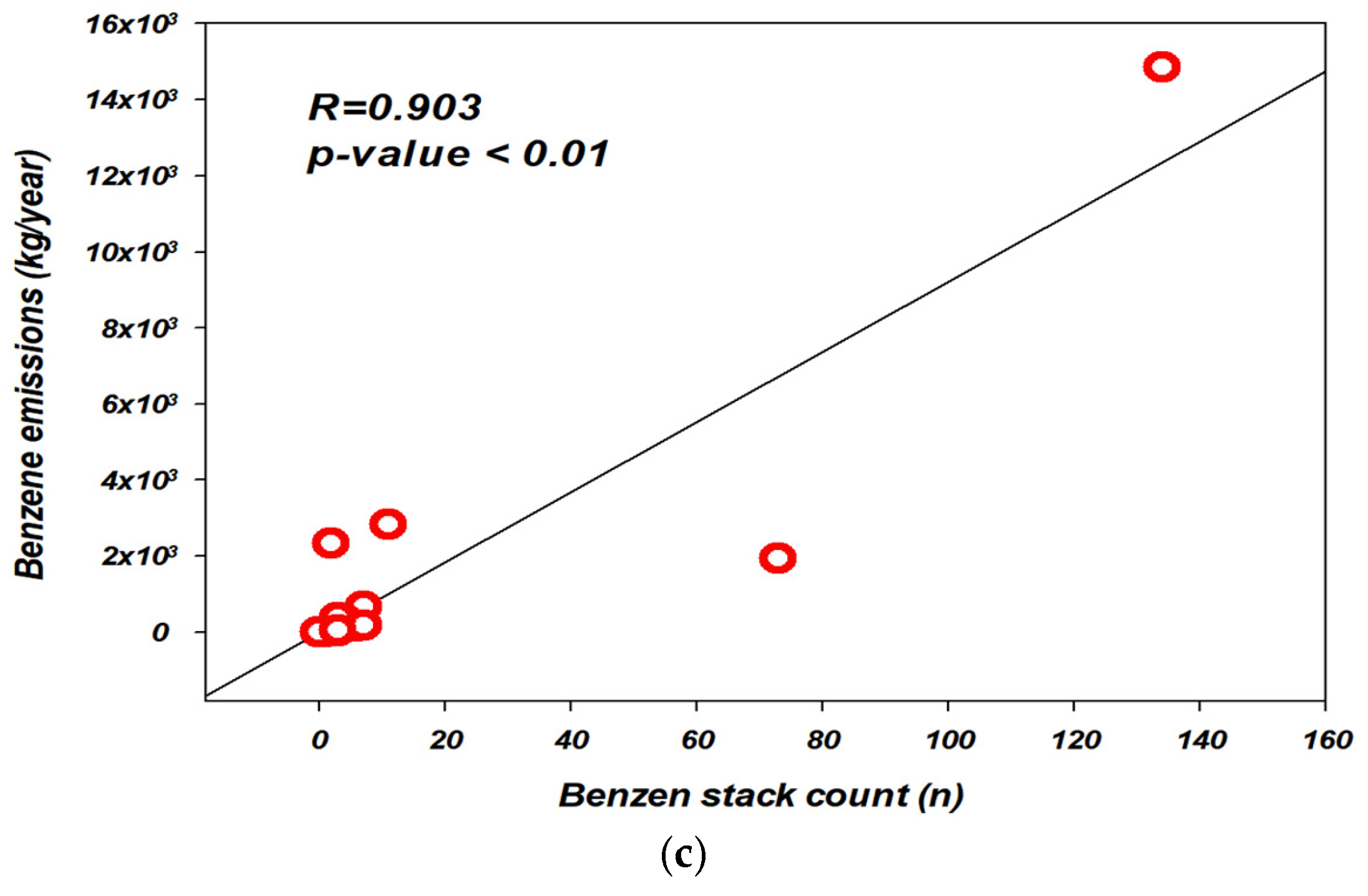
| Category Range | Country | Averaging Interval | Standard (µg/m3) |
|---|---|---|---|
| <5 µg/m3 | France | Annual | 2 |
| Israel | Annual | 1.3 | |
| Iraq | Annual | 3 | |
| Japan | Annual | 3 | |
| Israel | 24 h | 3.9 | |
| New Zealand | Annual | 3.6 | |
| Scotland | Annual | 3.25 | |
| North Ireland | Annual | 3.25 | |
| Peru | Annual | 4 | |
| Sweden | Annual | Upper threshold 3.5 | |
| Malta | Annual | Upper threshold 3.5 | |
| 5 µg/m3 | India, Lebanon, Russia, South Korea, Botswana, European Union, Colombia | Annual | 5 |
| Albania | 8 h | 5 | |
| ≤10 µg/m3 | Russia | 24 h | 100 |
| 20 min | 300 | ||
| Syria | Annual | 20 | |
| Vietnam | 1 h | 22 | |
| Annual | 10 | ||
| Morocco | Annual | 10 | |
| South Africa | Annual | 10 | |
| Belarus | 24 h | 40 | |
| Annual | 10 | ||
| Cuba | 20 min | 1000 |
| Month | Mean | SD | Min | Max | GM | 5th | 25th | 50th | 75th | 95th | p-Value | Post Hoc |
|---|---|---|---|---|---|---|---|---|---|---|---|---|
| Jan. a | 23.55 | 80.33 | 0.01 | 1132.51 | 8.09 | 1.06 | 4.59 | 7.89 | 13.64 | 77.66 | 0.01 | b, c, d, e, f, g, h, i, j, k, l |
| Feb. b | 64.28 | 194.69 | 0.01 | 1955.38 | 5.13 | 0.26 | 1.41 | 3.62 | 11.96 | 451.14 | a, c, e, f, g, h, i, j, k, l | |
| Mar. c | 5.90 | 7.30 | 0.01 | 171.25 | 3.73 | 0.46 | 2.25 | 4.83 | 7.77 | 12.71 | a, b, d, e, f, i, j, k, l | |
| Apr. d | 20.35 | 50.31 | 0.01 | 588.31 | 5.44 | 0.48 | 2.40 | 5.16 | 10.10 | 116.74 | a, c, e, f, g, h, i, j, l | |
| May. e | 7.30 | 10.12 | 0.01 | 178.09 | 4.03 | 0.41 | 2.17 | 4.88 | 8.76 | 21.67 | a, b, c, d, f, h, i, j, k | |
| Jun. f | 5.51 | 7.65 | 0.01 | 97.78 | 3.02 | 0.32 | 1.58 | 3.58 | 7.22 | 14.09 | a, b, c, d, e, g, h, i, j, l | |
| Jul. g | 7.50 | 24.41 | 0.01 | 552.5 | 3.94 | 0.53 | 2.58 | 4.88 | 7.18 | 13.54 | a, b, d, f, h, i, j, k | |
| Aug. h | 6.26 | 12.05 | 0.01 | 214.60 | 3.53 | 0.50 | 2.18 | 4.08 | 6.40 | 16.64 | a, b, d, e, f, g, j, k, l | |
| Oct. i | 6.37 | 9.93 | 0.01 | 150.40 | 3.32 | 0.35 | 1.80 | 3.87 | 6.94 | 21.66 | a, b, c, d, e, f, g, j, k, l | |
| Nov. j | 6.45 | 5.59 | 0.01 | 104.11 | 4.54 | 0.71 | 2.94 | 5.53 | 8.72 | 13.90 | a, b, c, d, e, f, g, h, i, k, l | |
| Nov (2). k | 12.97 | 31.44 | 0.01 | 619.48 | 5.66 | 0.68 | 2.99 | 5.81 | 11.07 | 48.12 | a, b, c, e, f, g, h, i, j, l | |
| Dec. l | 10.37 | 25.74 | 0.01 | 361.01 | 3.98 | 0.39 | 1.92 | 4.42 | 8.61 | 36.81 | a, b, d, f, h, i, j, k |
| Block | Corporation | Benzene Used | Operation Process | Emission (kg/Year) | Total Stack Count (n) | Benzene Stack Count (n) | Storage Tank | Detection Frequency |
|---|---|---|---|---|---|---|---|---|
| A | #1 | used | RTO (Regenerative Thermal Oxidizer) | 22.38 | 9 | 3 | - | N.D. |
| B | #2 | used | Manufacture, Storage, RTO (Regenerative Thermal Oxidizer) | 1932.53 | 109 | 73 | Install | 28 |
| C | #3 | used | Manufacture RTO (Regenerative Thermal Oxidizer) | 685.85 | 12 | 7 | - | 23 |
| D | #4 | used | Manufacture VCU (Vapor Combustion Unit) | 2339.35 | 22 | 2 | - | 20 |
| E | #5 | used | Supply of raw material Transfer of raw material A/C TOWER (Activated Carbon Tower) | 0.066 | 6 | 1 | - | N.D. |
| F | #6 | used | Manufacture RTO (Regenerative Thermal Oxidizer) Vent gas treatment | 14,844.33 | 149 | 134 | - | 32 |
| G | #7, #8 | used | REACTOR Fracking process | 2819.09 | 15 | 11 | - | 41 |
| H | #9 | used | RTO (Regenerative Thermal Oxidizer) Manufacture | 155.206 | 12 | 6 | N.D. | |
| I | #10 | not used | - | 0 | - | - | - | 1 |
| J | #11 | used | Storage of raw material | 315.83 | 7 | 4 | Install | 25 |
| K | #12 | used | Manufacture CTO (Catalytic Thermal Oxidizer) | 145.931 | 18 | 5 | - | 15 |
| L | #13 | used | TO (Thermal Oxidizer) RTO (Regenerative Thermal Oxidizer) | 0 | 2 | 0 | - | N.D. |
| M | #14 | used | Manufacture RTO (Regenerative Thermal Oxidizer) | 172.64 | 15 | 7 | - | 1 |
| N | #15, 16 | not used | - | 0 | - | - | - | 4 |
| O | #17 | used | Manufacture, Storage VCU (Vapor Combustion Unit) RTO (Regenerative Thermal Oxidizer) | 381 | 16 | 3 | Install | 1 |
| P | #18 | not used | - | 0 | - | - | - | 1 |
| Q | #19 | used | Storage, Supply of raw material Melting, Fusion | 60.976 | 12 | 3 | Install | N.D. |
Disclaimer/Publisher’s Note: The statements, opinions and data contained in all publications are solely those of the individual author(s) and contributor(s) and not of MDPI and/or the editor(s). MDPI and/or the editor(s) disclaim responsibility for any injury to people or property resulting from any ideas, methods, instructions or products referred to in the content. |
© 2025 by the authors. Licensee MDPI, Basel, Switzerland. This article is an open access article distributed under the terms and conditions of the Creative Commons Attribution (CC BY) license (https://creativecommons.org/licenses/by/4.0/).
Share and Cite
Lee, D.k.; Park, J.-m.; Jang, J.-h.; Jung, J.-s.; Kim, M.-k.; Heo, J.; Park, D. Spatiotemporal Assessment of Benzene Exposure Characteristics in a Petrochemical Industrial Area Using Mobile-Extraction Differential Optical Absorption Spectroscopy (Me-DOAS). Toxics 2025, 13, 655. https://doi.org/10.3390/toxics13080655
Lee Dk, Park J-m, Jang J-h, Jung J-s, Kim M-k, Heo J, Park D. Spatiotemporal Assessment of Benzene Exposure Characteristics in a Petrochemical Industrial Area Using Mobile-Extraction Differential Optical Absorption Spectroscopy (Me-DOAS). Toxics. 2025; 13(8):655. https://doi.org/10.3390/toxics13080655
Chicago/Turabian StyleLee, Dong keun, Jung-min Park, Jong-hee Jang, Joon-sig Jung, Min-kyeong Kim, Jaeseok Heo, and Duckshin Park. 2025. "Spatiotemporal Assessment of Benzene Exposure Characteristics in a Petrochemical Industrial Area Using Mobile-Extraction Differential Optical Absorption Spectroscopy (Me-DOAS)" Toxics 13, no. 8: 655. https://doi.org/10.3390/toxics13080655
APA StyleLee, D. k., Park, J.-m., Jang, J.-h., Jung, J.-s., Kim, M.-k., Heo, J., & Park, D. (2025). Spatiotemporal Assessment of Benzene Exposure Characteristics in a Petrochemical Industrial Area Using Mobile-Extraction Differential Optical Absorption Spectroscopy (Me-DOAS). Toxics, 13(8), 655. https://doi.org/10.3390/toxics13080655








